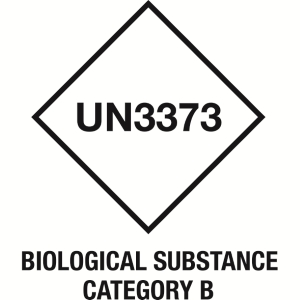The text of United Nations Packing Instruction 650, in use for the transport of infectious substances in category B assigned to UN 3373 by all surface modes of transport is reproduced below. The various provisions mentioned are set out in the United Nations Model Regulations.
(1) The packaging shall be of good quality, strong enough to withstand the shocks and loadings normally encountered during transport, including trans-shipment between transport units and between transport units and warehouses as well as any removal from a pallet or overpack for subsequent manual or mechanical handling. Packagings shall be constructed and closed to prevent any loss of contents that might be caused under normal conditions of transport by vibration or by changes in temperature, humidity or pressure.
(2) The packaging shall consist of three components:
(a) a primary receptacle,
(b) a secondary packaging, and
(c) an outer packaging of which either the secondary or the outer packaging shall be rigid
(3) Primary receptacles shall be packed in secondary packagings in such a way that, under normal conditions of transport, they cannot break, be punctured or leak their contents into the secondary packaging. Secondary packagings shall be secured in outer packagings with suitable cushioning material. Any leakage of the contents shall not compromise the integrity of the cushioning material or of the outer packaging.
(4) For transport, the mark illustrated below shall be displayed on the external surface of the outer packaging on a background of a contrasting colour and shall be clearly visible and legible. The mark must be in the form of a square set at an angle of 45° (diamond-shaped) with each side having a length of at least 50 mm; the width of the line shall be at least 2 mm and the letters and numbers shall be at least 6 mm high. The proper shipping name “BIOLOGICAL SUBSTANCE, CATEGORY B” in letters at least 6 mm high must be marked on the outer package adjacent to the diamond-shaped mark.

(5) At least one surface of the outer packaging must have a minimum dimension of 100 mm × 100 mm.
(6) The completed package shall be capable of successfully passing the drop test in 6.3.5.3 as specified in 6.3.5.2 of these Regulations at a height of 1.2 m. Following the appropriate drop sequence, there shall be no leakage from the primary receptacle(s) which shall remain protected by absorbent material, when required, in the secondary packaging.
(7) For liquid substances
(a) The primary receptacle(s) shall be laeakproof;
(b) The secondary packaging shall be leakproof;
(c) If multiple fragile primary receptacles are placed in a single secondary packaging, they shall be either individually wrapped or separated to prevent contact between them;
(d) Absorbent material shall be placed between the primary receptacle(s) and the secondary packaging. The absorbent material shall be in quantity sufficient to absorb the entire contents of the primary receptacle(s) so that any release of the liquid substance will not compromise the integrity of the cushioning material or of the outer packaging;
(e) The primary receptacle or the secondary packaging shall be capable of withstanding, without leakage, an internal pressure of 95 kPa (0.95 bar).
(8) For solid substances
(a) The primary receptacle(s) shall be siftproof;
(b) The secondary packaging shall be siftproof;
(c) If multiple fragile primary receptacles are placed in a single secondary packaging, they shall be either individually wrapped or separated to prevent contact between them.
(d) If there is any doubt as to whether or not residual liquid may be present in the primary receptacle during transport, then packaging suitable for liquids, including absorbent materials, shall be used.
(9) Refrigerated or frozen specimens: Ice, dry ice and liquid nitrogen
(a) When dry ice or liquid nitrogen is used to keep specimens cold, all applicable requirements of these Regulations shall be met. When used, ice or dry ice shall be placed outside the secondary packagings or in the outer packaging or an overpack. Interior supports shall be provided to secure the secondary packagings in the original position. If ice is used, the outside packaging or overpack shall be leakproof. If carbon dioxide, solid (dry ice) is used, the packaging shall be designed and constructed to permit the release of carbon dioxide gas to prevent a build-up of pressure that could rupture the packagings and the package (the outer packaging or the overpack) shall be marked “Carbon dioxide, solid” or “Dry ice”.
(b) The primary receptacle and the secondary packaging shall maintain their integrity at the temperature of the refrigerant used as well as the temperatures and the pressures which could result if refrigeration were lost.
(10) When packages are placed in an overpack, the package markings required by this packing instruction shall either be clearly visible or be reproduced on the outside of the overpack.
(11) Infectious substances assigned to UN 3373 which are packed and marked in accordance with this packing instruction are not subject to any other requirement in these Regulations.
(12) Clear instructions on filling and closing such packages shall be provided by packaging manufacturers and subsequent distributors to the consignor or to the person who prepares the package (e.g. patient) to enable the package to be correctly prepared for transport.
(13) Other dangerous goods shall not be packed in the same packaging as Division 6.2 infectious substances unless they are necessary for maintaining the viability, stabilizing or preventing degradation or neutralizing the hazards of the infectious substances. A quantity of 30 ml or less of dangerous goods included in Classes 3 (flammable liquids), 8 (corrosives) or 9 (miscellaneous dangerous substances and articles, including environmentally hazardous substances) may be packed in each primary receptacle containing infectious substances. When these small quantities of dangerous goods are packed with infectious substances in accordance with this packing instruction no other requirements in these Instructions need be met.
Reference: WHO (updated June 2018)


